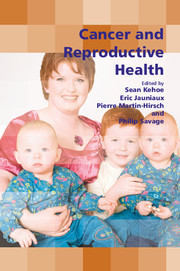Book contents
- Frontmatter
- Contents
- Participants
- Preface
- SECTION 1 Epidemiology, Genetics and Basic Principles of Chemotherapy and Radiotherapy
- SECTION 2 Fertility Issues and Paediatric Cancers
- SECTION 3 Gynaecological Cancers and Precancer
- 9 Management of cervical intraepithelial neoplasia during pregnancy
- 10 Impact of LLETZ on subsequent pregnancies
- 11 Ovarian masses and malignancies
- 12 Cervical and endometrial cancer in relation to pregnancy
- SECTION 4 Diagnostic Dilemmas
- SECTION 5 The Placenta
- SECTION 6 Non-Gynaecological Cancers
- SECTION 7 Multidisciplinary Care and Service Provision
- SECTION 8 Consensus Views
- Index
12 - Cervical and endometrial cancer in relation to pregnancy
from SECTION 3 - Gynaecological Cancers and Precancer
Published online by Cambridge University Press: 05 October 2014
- Frontmatter
- Contents
- Participants
- Preface
- SECTION 1 Epidemiology, Genetics and Basic Principles of Chemotherapy and Radiotherapy
- SECTION 2 Fertility Issues and Paediatric Cancers
- SECTION 3 Gynaecological Cancers and Precancer
- 9 Management of cervical intraepithelial neoplasia during pregnancy
- 10 Impact of LLETZ on subsequent pregnancies
- 11 Ovarian masses and malignancies
- 12 Cervical and endometrial cancer in relation to pregnancy
- SECTION 4 Diagnostic Dilemmas
- SECTION 5 The Placenta
- SECTION 6 Non-Gynaecological Cancers
- SECTION 7 Multidisciplinary Care and Service Provision
- SECTION 8 Consensus Views
- Index
Summary
Introduction
The diagnosis of cancer confronts patients, their families and carers with considerable challenges. The assessment of the disease, discussion of treatment options and the effects of treatment in both the short and long term need to be addressed. For women with gynaecological cancers, these challenges include the effect on perceptions of womanhood and, for some, the effect on future fertility.
This chapter considers cervical and endometrial cancer in relation to pregnancy, dealing with both the situation where the diagnosis is made at a time when future pregnancy is desired and the situation where the diagnosis is made during pregnancy. The issues surrounding diagnosis and treatment in these situations differ in some important respects.
For women diagnosed at a time when future fertility is desired, it is important to provide adequate information on the treatment options as well as the likely chances of subsequent pregnancy and the potential complications of treatment that may affect such pregnancies.
After the diagnosis of cancer, patients and their families are emotionally vulnerable. Treatment options must be considered along with the psychosocial consequences of those choices. There will be situations where a fertility-sparing treatment may be considered that, from a purely oncological point of view, may result in a poorer outcome but that the woman finds acceptable in view of the fertility-preserving nature of such a treatment. Full discussion of these issues is crucial to help women and their families plan the appropriate individualised management strategy in each case.
Keywords
- Type
- Chapter
- Information
- Cancer and Reproductive Health , pp. 133 - 144Publisher: Cambridge University PressPrint publication year: 2008
- 1
- Cited by

